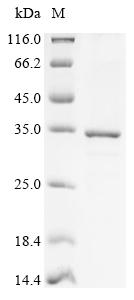The production of the recombinant human mitochondrial thiamine pyrophosphate carrier (SLC25A19) is carried out in an in vitro E. coli expression system. The gene fragment encoding the full-length human SLC25A19 protein (1-320aa), along with an N-terminal 10xHis-tag for purification purposes, is incorporated into an expression vector. In the cell-free system, the vector construct is mixed with an E. coli cell lysate that contains the necessary cellular components for transcription and translation. The mixture is then incubated under appropriate conditions to allow for the expression of the recombinant SLC25A19 protein. Following the expression, the recombinant SLC25A19 protein is obtained from the cell-free expression system. Purity analysis using SDS-PAGE demonstrates that the recombinant human SLC25A19 protein exhibits a purity level of up to 85%.






